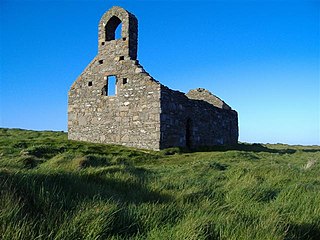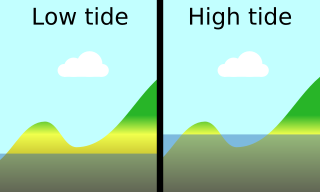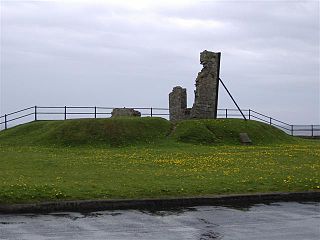
The Isle of Man is an island in the Irish Sea, between Great Britain and Ireland in Northern Europe, with a population of almost 85,000. It is a British Crown dependency. It has a small islet, the Calf of Man, to its south. It is located at 54°15′N4°30′W.

St Michael's Isle, more commonly referred to as Fort Island, is an island in Malew parish in the Isle of Man, noted for its attractive ruins. It covers an area of 5.14 hectares, is about 400 metres long from west to east, and is connected to the Langness Peninsula, near Derbyhaven, by a narrow causeway. The island itself is made of rocky slate and the soil is very acidic. Nevertheless, it has important communities of maritime plants.

Castletown is a town in the Isle of Man, geographically within the historical parish of Malew but administered separately. Lying at the south of the island, it was the Manx capital until 1869. The centre of town is dominated by Castle Rushen, a well-preserved medieval castle, originally built for a Viking king.

Peel is a seaside town and small fishing port in the Isle of Man, in the historic parish of German but administered separately. Peel is the third largest town in the island after Douglas and Ramsey but the fourth largest settlement, as Onchan has the second largest population but is classified as a village.

Sanday is one of the inhabited islands of Orkney that lies off the north coast of mainland Scotland. With an area of 50.43 km2 (19.5 sq mi), it is the third largest of the Orkney Islands. The main centres of population are Lady Village and Kettletoft. Sanday can be reached by Orkney Ferries or by plane from Kirkwall on the Orkney Mainland. On Sanday, an on-demand public minibus service allows connecting to the ferry.

A tidal island is a raised area of land within a waterbody, which is connected to the larger mainland by a natural isthmus or man-made causeway that is exposed at low tide and submerged at high tide, causing the land to switch between being a promontory/peninsula and an island depending on tidal conditions.

Illiam Dhone or Illiam Dhône, also known as William Christian, was a Manx politician and depending on viewpoint, patriot, rebel or traitor. He was a son of Ewan Christian, a deemster. In Manx, Illiam Dhone literally translates to Brown William—an epithet he received due to his dark hair—and in English he was called Brown-haired William. Dhone was a significant figure in the Isle of Man during the English Civil War and the Manx Rebellion of 1651. He was executed for high treason in 1663. In the centuries after his death he has become a "martyr and folk-hero, a symbol of the Island's cherished freedoms and traditional rights".

Dreswick Point is the southernmost point of the main island of the Isle of Man. It is the southern tip of the Langness Peninsula in the south-east of the island, some 2+1⁄2 miles (4.0 km) from Castletown.

Isle of Man Airport is the main civilian airport on the Isle of Man. It is located in the south of the island at Ronaldsway near Castletown, 6 nautical miles southwest of Douglas, the island's capital. Along with the Isle of Man Sea Terminal, it is one of the two main gateways to the island. The airport has scheduled services to the United Kingdom and the Republic of Ireland.

Derbyhaven is a hamlet near Castletown in the southern parish of Malew, Isle of Man. It is located on the isthmus connecting Langness Peninsula to the rest of the island, on the bay of the same name, and also on Castletown Bay on the other side of the isthmus.

The Battle of Ronaldsway took place in 1275 at Ronaldsway in the southern part of the Isle of Man between a Scottish army and the Manx. The battle crushed the final attempt by the Manx to re-establish the Norse Sudreyar dynasty. As the battle resulted in the death of the last Norse King of Mann, Guðrøðr Magnússon, and the emigration to Norway of the remaining members of the Manx royal family, it also led to the firm establishment of Scottish rule on the Isle of Man.
Castletown Golf Links is a championship links course at Derbyhaven on the Isle of Man. Its setting on Langness Peninsula provides views of the Irish Sea from all tees, fairways, and greens. The Links was founded in originally laid out by Old Tom Morris in 1891, with Castletown Golf Club founded in 1892. Dr Alister MacKenzie made significant improvements and alterations to the course in 1913. After the war the course was updated by Mackenzie Ross.

Rushen is one of the six sheadings of the Isle of Man.

Malew is one of the seventeen parishes of the Isle of Man.

For a small country, sport in the Isle of Man plays an important part in making the island known to the wider world. The principal international sporting event held on the island is the annual Isle of Man TT motorcycling event. However, the Isle of Man is represented internationally in a number of other sports at the Commonwealth Games and the Island Games.

Raad ny Foillan is a coastal long-distance footpath in the Isle of Man. Because it is a closed loop around the coast, it can be walked in either a clockwise or an anti-clockwise direction.

Rugby union in the Isle of Man is a popular sport. It has no national competitive side of its own, and is not affiliated to the IRB in its own right. For this reason, it has no IRB ranking.

Western Vikings Rugby Club is a rugby union team based in Peel, Isle of Man. They are affiliated to the Cheshire Rugby Football Union and in turn the English Rugby Football Union.

Hango Hill is an historic mound on the coast road between Castletown and Derbyhaven, Malew parish, Isle of Man.




















